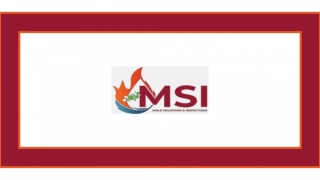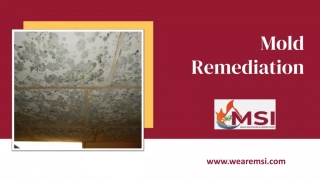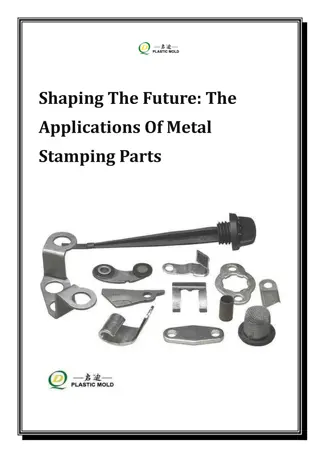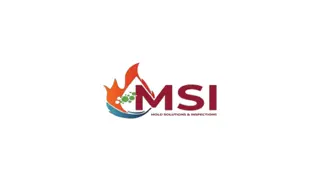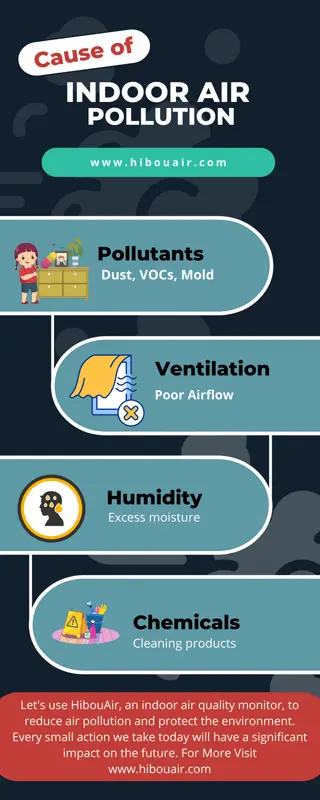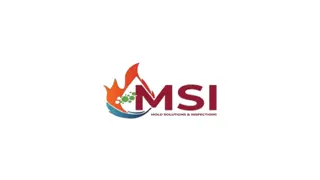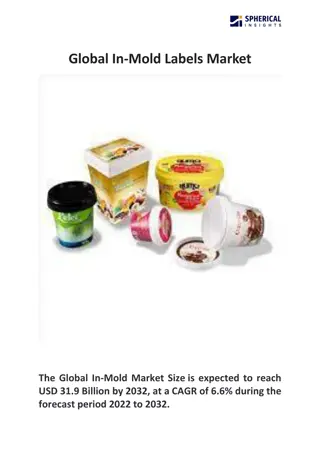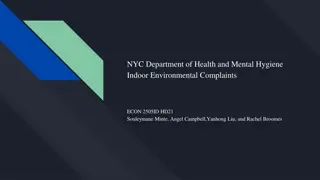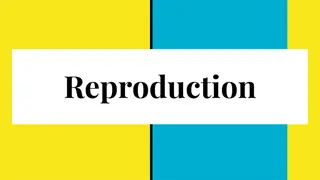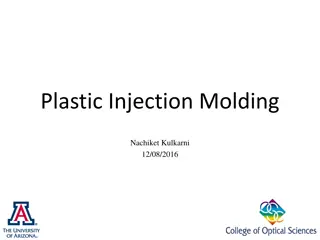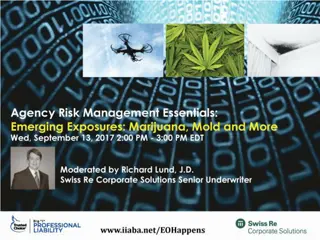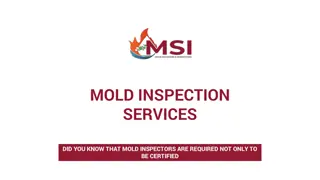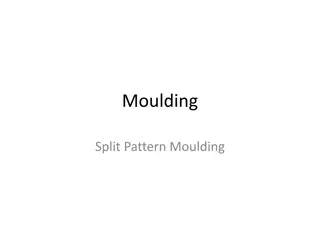Understanding Mold Awareness and Health Risks
Mold awareness is crucial for preventing health risks associated with exposure to mold. Mold requires moisture, warmth, and food to grow, with common growth areas being the bathroom, basement, and kitchen. Exposure to mold can lead to allergic reactions, infections, and toxic effects, posing a higher risk to infants, children, the elderly, and individuals with respiratory conditions or allergies. Recognizing what mold looks like and understanding its growth process is vital for effective prevention strategies.
Uploaded on Sep 13, 2024 | 0 Views
Download Presentation

Please find below an Image/Link to download the presentation.
The content on the website is provided AS IS for your information and personal use only. It may not be sold, licensed, or shared on other websites without obtaining consent from the author. Download presentation by click this link. If you encounter any issues during the download, it is possible that the publisher has removed the file from their server.
E N D
Presentation Transcript
Mold Awareness Bureau of Workers Comp PA Training for Health & Safety (PATHS) PPT-059-01 1
Causes of Mold Mold spores are always present but require a favorable environment to become active 1.Humidity or Moisture If RH (relative humidity) is over 70% for an extended period of time mold growth is almost inevitable. 2.Temperature Higher temperatures increase RH: mold growth. Below 70 degrees is best for prevention. 3.Stagnant Air Air movement aids in evaporation and decreases moisture. Use to prevent not to cure! 4.Darkness UV rays help retard growth. PPT-059-01 2
Mold Needs: MOISTURE, WARMTH, FOOD All three conditions necessary for growth. Most likely growing places: bathroom, basement, kitchen. Can grow in other rooms if conditions are favorable. Climate where you live and living habits can affect ability to grow. PPT-059-01 3
Health Effects of Mold Exposure to mold can occur when airborne mold cells, mostly spores, are inhaled. We breathe in these cells every day, indoors and out. Usually these exposures do not present a health risk. But when exposure is great, some individuals (e.g. those with allergies and asthma) can experience mild to serious illness. PPT-059-01 4
Health Effects of Mold The following is a description of the health problems that can be caused by exposure to mold: Allergic Illness When mold cells are inhaled and land in the respiratory tract, the body's immune system's response to those invading cells can cause an allergic response (e.g. sneezing, runny nose, etc.). Infection Some mold species can cause respiratory infection when the live mold invades the tissues of the lungs or respiratory tract. Toxic Effects Very large doses of certain molds, whether inhaled or ingested, can result in poisoning caused by toxins, called mycotoxins, in the mold cells. PPT-059-01 5
Health Effects of Mold Exposure to mold is not healthy for anyone, however the following individuals are at a higher health risk: o Infants o Children o Elderly o Immune Comprised Patients o Pregnant Women o People with existing respiratory conditions or allergies PPT-059-01 6
What Does Mold Look Like? PPT-059-01 7
Spore Growth PPT-059-01 8
Growth Timelines Effects of Time on Microbial Contamination Level 1 2 3 4 5 Day 6 7 PPT-059-01 9
Quick Fixes Dont Work Treating mold outbreaks with Lysol, bleach, fumigants or fungicides will not help. Only a few of these products will kill mold. None prevent future outbreaks and many are harmful to contents, documents and people. Do not introduce airflow. Mold spores are airborne. Do not wipe off the mold. You are helping it spread. PPT-059-01 10
Mold Remediation Mold testing and remediation requires a professional! Attempting to identify, remediate, clean, dry or in any way personally deal with mold without the appropriate training is not recommended. PPT-059-01 11
Find the Cause and Fix It 6 oversimplified steps to mold remediation: - For mold to grow there must be moisture. 1. Find out what is introducing moisture into your environment and stop it. 2. Remove the excess moisture. 3. Mop, sponge, vacuum and squeegee standing water out of area. PPT-059-01 12
Isolate the Area & Use PPE 4. The affected area must be sealed off from people, objects and areas. 5. The area must not be entered without PPE. 6. If desired, mold can be tested and identified. PPT-059-01 13
Determine Presence PPT-059-01 14
Begin Drying Excess moisture removed; now four ingredients of drying used to dry the environment(extraction, humidity control, air movement, temperature). Contents usually left in the area (this area will be used as a drying chamber). Once contents are dry mold will go dormant (must be a negative air environment). NOTE: If drying cannot be accomplished or will take more then 48 hours to begin, contents can be frozen. PPT-059-01 15
Negative Air? Negative air refers to the act of scrubbing the air with a HEPA filtering device and discharging it outside of the sealed environment. (HEPA = High Efficiency Particulate Air) PPT-059-01 16
Clean the Contents Area is dry and mold has gone dormant. Do not try to clean active mold! Mold must be cleaned in a negative air environment. Most solutions require mold to be removed with HEPA filter vacuums. Use special attachments including screens and brushes attached to suction so surfaces are not damaged. As contents are cleaned they are isolated from room to prevent further exposure. PPT-059-01 17
Clean the Area o Area is dry and mold is dormant. o Follow the same procedures used in contents cleaning. o All surfaces in the area must be cleaned. o HVAC components should be cleaned at this time. o After surfaces appear to be free of mold, fungicides can be used. PPT-059-01 18
Monitor the Area Contents have been cleaned and isolated. Source has been identified and dealt with. Area has been cleaned. Area has been re-tested for mold. Area has been monitored and corrected environment persists. Return contents to area. PPT-059-01 19
Mold Elimination Eliminate one of these elements and mold won t thrive: Food Source? Expensive & unlikely Temperature Zone? Bake the house? Moisture? All we need to remove is the excess! PPT-059-01 20
Assessment Most assessment of microbial is visual 1. Look for visible growth first. 2. Consider potential for hidden growth (is there moisture hidden in the walls, HVAC, etc.). 3. How far has it/will it spread? 4. Why did the mold start or how did the moisture get there? PPT-059-01 21
Visual 5. You need to take care of the existing problem: consider the chances of the damage reoccurring. 6. Is the building envelope the culprit, or possibly the exterior insulated finish systems to blame? 7. Determine if a moisture source is a reservoir or an amplifier. PPT-059-01 22
Mold Assessment: Sampling 1. Assesses occupant exposure Immune Deficiencies 2. Determine potential exposures 3. Possibly help locate hidden contamination Should not be required in most cases PPT-059-01 23
More on Sampling 4. Methods (Suggest a Certified Industrial Hygienist) Tape Lift Bulk Dust Swab Bulk Material Air Sampling Directory for CIH s: www.aiha.org or www.abih.org 5. In most cases of 30 square feet or greater, clearance testing is highly recommended PPT-059-01 24
Remember Treating mold outbreaks with Lysol, bleach, fumigants or fungicides will not help. Only a few of these products will kill mold. None prevent future outbreaks and many are harmful to contents, documents and people. Do not introduce airflow. Mold spores are airborne. Do not wipe off the mold. You are helping it spread. PPT-059-01 25
Summary 1. Causes of Mold: - Humidity or Moisture - Temperature - Stagnant Air - Darkness 2. Mold needs 3 things to grow: - Food source - Temperature zone - Moisture PPT-059-01 26
Contact Information Health & Safety Training Specialists 1171 South Cameron Street, Room 324 Harrisburg, PA 17104-2501 (717) 772-1635 RA-LI-BWC-PATHS@pa.gov Like us on Facebook! - https://www.facebook.com/BWCPATHS PPT-059-01 27
Questions PPT-059-01 28


